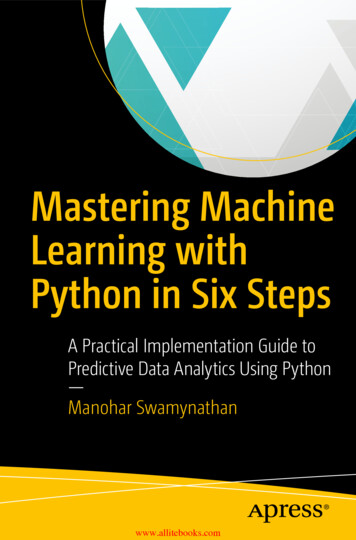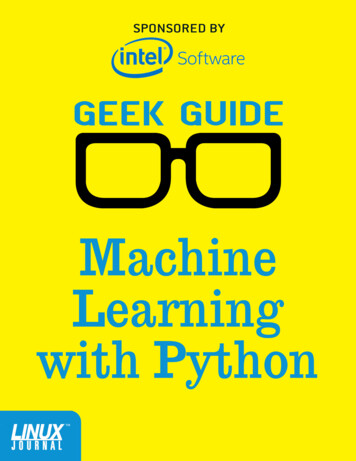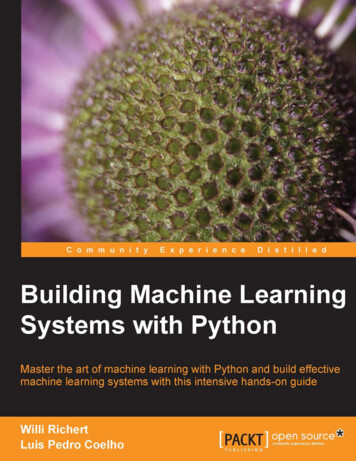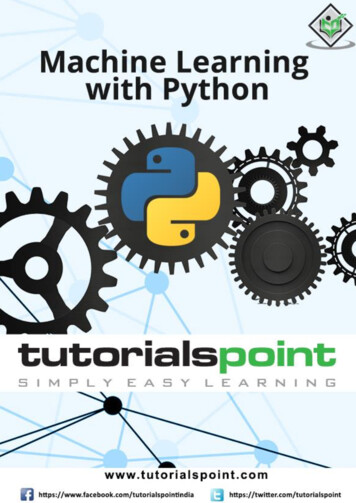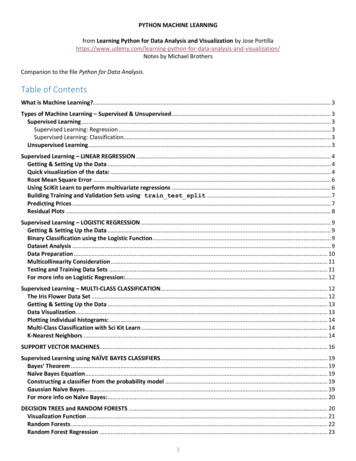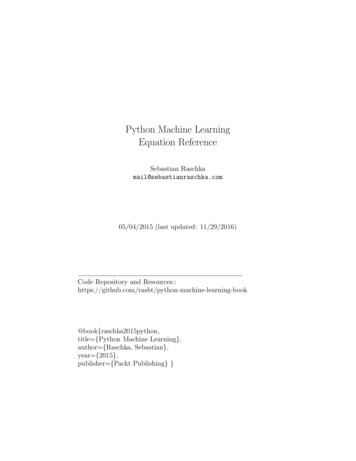
Transcription
Python Machine LearningEquation ReferenceSebastian Raschkamail@sebastianraschka.com05/04/2015 (last updated: 11/29/2016)Code Repository and -learning-book@book{raschka2015python,title {Python Machine Learning},author {Raschka, Sebastian},year {2015},publisher {Packt Publishing} }
Contents1 Giving Computers the Ability to Learn from Data1.1 Building intelligent machines to transform data into knowledge1.2 The three different types of machine learning . . . . . . . . . .1.3 Making predictions about the future with supervised learning .1.3.1 Classification for predicting class labels . . . . . . . . .1.3.2 Regression for predicting continuous outcomes . . . . .1.4 Solving interactive problems with reinforcement learning . . . .1.5 Discovering hidden structures with unsupervised learning . . .1.5.1 Finding subgroups with clustering . . . . . . . . . . . .1.5.2 Dimensionality reduction for data compression . . . . .1.6 An introduction to the basic terminology and notations . . . .1.7 A roadmap for building machine learning systems . . . . . . . .1.7.1 Preprocessing – getting data into shape . . . . . . . . .1.7.2 Training and selecting a predictive model . . . . . . . .1.7.3 Evaluating models and predicting unseen data instances1.8 Using Python for machine learning . . . . . . . . . . . . . . . .1.8.1 Installing Python packages . . . . . . . . . . . . . . . .1.9 Summary . . . . . . . . . . . . . . . . . . . . . . . . . . . . . .2 Training Machine Learning Algorithms for Classification2.1 Artificial neurons – a brief glimpse into the early history of machine learning . . . . . . . . . . . . . . . . . . . . . . . . . . . . .2.2 Implementing a perceptron learning algorithm in Python . . . . .2.2.1 Training a perceptron model on the Iris dataset . . . . . .2.3 Adaptive linear neurons and the convergence of learning . . . . .2.3.1 Minimizing cost functions with gradient descent . . . . .2.3.2 Implementing an Adaptive Linear Neuron in Python . . .2.3.3 Large scale machine learning and stochastic gradient descent2.4 Summary . . . . . . . . . . . . . . . . . . . . . . . . . . . . . . .3 A Tour of Machine Learning Classifiers Using3.1 Choosing a classification algorithm . . . . . . .3.2 First steps with scikit-learn . . . . . . . . . . .3.2.1 Training a perceptron via scikit-learn t-learn17. . . . . . . . . . 17. . . . . . . . . . 17. . . . . . . . . . 17
Sebastian Raschka3.33.43.53.63.73.8Python Machine Learning – Equation Reference – Ch. 0Modeling class probabilities via logistic regression . . . . . . . . .3.3.1 Logistic regression intuition and conditional probabilities3.3.2 Learning the weights of the logistic cost function . . . . .3.3.3 Training a logistic regression model with scikit-learn . . .3.3.4 Tackling overfitting via regularization . . . . . . . . . . .Maximum margin classification with support vector machines . .3.4.1 Maximum margin intuition . . . . . . . . . . . . . . . . .3.4.2 Dealing with the nonlinearly separable case using slackvariables . . . . . . . . . . . . . . . . . . . . . . . . . . . .3.4.3 Alternative implementations in scikit-learn . . . . . . . .Solving nonlinear problems using a kernel SVM . . . . . . . . . .3.5.1 Using the kernel trick to find separating hyperplanes inhigher dimensional space . . . . . . . . . . . . . . . . . .Decision tree learning . . . . . . . . . . . . . . . . . . . . . . . .3.6.1 Maximizing information gain – getting the most bang forthe buck . . . . . . . . . . . . . . . . . . . . . . . . . . . .3.6.2 Building a decision tree . . . . . . . . . . . . . . . . . . .3.6.3 Combining weak to strong learners via random forests . .K-nearest neighbors – a lazy learning algorithm . . . . . . . . . .Summary . . . . . . . . . . . . . . . . . . . . . . . . . . . . . . .4 Building Good Training Sets – Data Pre-Processing4.1 Dealing with missing data . . . . . . . . . . . . . . . . . . .4.1.1 Eliminating samples or features with missing values4.1.2 Imputing missing values . . . . . . . . . . . . . . . .4.1.3 Understanding the scikit-learn estimator API . . . .4.2 Handling categorical data . . . . . . . . . . . . . . . . . . .4.2.1 Mapping ordinal features . . . . . . . . . . . . . . .4.2.2 Encoding class labels . . . . . . . . . . . . . . . . . .4.2.3 Performing one-hot encoding on nominal features . .4.3 Partitioning a dataset in training and test sets . . . . . . .4.4 Bringing features onto the same scale . . . . . . . . . . . . .4.5 Selecting meaningful features . . . . . . . . . . . . . . . . .4.5.1 Sparse solutions with L1 regularization . . . . . . . .4.5.2 Sequential feature selection algorithms . . . . . . . .4.6 Assessing feature importance with random forests . . . . . .4.7 Summary . . . . . . . . . . . . . . . . . . . . . . . . . . . 626262627272728285 Compressing Data via Dimensionality Reduction295.1 Unsupervised dimensionality reduction via principal componentanalysis . . . . . . . . . . . . . . . . . . . . . . . . . . . . . . . . 295.1.1 Total and explained variance . . . . . . . . . . . . . . . . 305.1.2 Feature transformation . . . . . . . . . . . . . . . . . . . 305.1.3 Principal component analysis in scikit-learn . . . . . . . . 315.2 Supervised data compression via linear discriminant analysis . . 315.2.1 Computing the scatter matrices . . . . . . . . . . . . . . . 312
Sebastian Raschka5.35.4Python Machine Learning – Equation Reference – Ch. 05.2.25.2.35.2.4Using5.3.15.3.2Selecting linear discriminants for the new feature subspaceProjecting samples onto the new feature space . . . . . .LDA via scikit-learn . . . . . . . . . . . . . . . . . . . . .kernel principal component analysis for nonlinear mappingsKernel functions and the kernel trick . . . . . . . . . . . .Implementing a kernel principal component analysis inPython . . . . . . . . . . . . . . . . . . . . . . . . . . . .5.3.3 Projecting new data points . . . . . . . . . . . . . . . . .5.3.4 Kernel principal component analysis in scikit-learn . . . .Summary . . . . . . . . . . . . . . . . . . . . . . . . . . . . . . .6 Learning Best Practices for Model Evaluation and Hyperparameter Tuning6.1 Streamlining workflows with pipelines . . . . . . . . . . . . . . .6.1.1 Loading the Breast Cancer Wisconsin dataset . . . . . . .6.1.2 Combining transformers and estimators in a pipeline . . .6.2 Using k-fold cross-validation to assess model performance . . . .6.2.1 The holdout method . . . . . . . . . . . . . . . . . . . . .6.2.2 K-fold cross-validation . . . . . . . . . . . . . . . . . . . .6.3 Debugging algorithms with learning and validation curves . . . .6.3.1 Diagnosing bias and variance problems with learning curves6.3.2 Addressing overfitting and underfitting with validationcurves . . . . . . . . . . . . . . . . . . . . . . . . . . . . .6.4 Fine-tuning machine learning models via grid search . . . . . . .6.4.1 Tuning hyperparameters via grid search . . . . . . . . . .6.4.2 Algorithm selection with nested cross-validation . . . . .6.5 Looking at different performance evaluation metrics . . . . . . .6.5.1 Reading a confusion matrix . . . . . . . . . . . . . . . . .6.5.2 Optimizing the precision and recall of a classification model6.5.3 Plotting a receiver operating characteristic . . . . . . . .6.5.4 The scoring metrics for multiclass classification . . . . . .6.6 Summary . . . . . . . . . . . . . . . . . . . . . . . . . . . . . . .7 Combining Different Models for Ensemble Learning7.1 Learning with ensembles . . . . . . . . . . . . . . . . . . . . . . .7.2 Implementing a simple majority vote classifier . . . . . . . . . . .7.2.1 Combining different algorithms for classification with majority vote . . . . . . . . . . . . . . . . . . . . . . . . . . .7.3 Evaluating and tuning the ensemble classifier . . . . . . . . . . .7.4 Bagging – building an ensemble of classifiers from bootstrap samples7.5 Leveraging weak learners via adaptive boosting . . . . . . . . . .7.6 Summary . . . . . . . . . . . . . . . . . . . . . . . . . . . . . . 383939394040414242424244
Sebastian RaschkaPython Machine Learning – Equation Reference – Ch. 08 Applying Machine Learning to Sentiment Analysis458.1 Obtaining the IMDb movie review dataset . . . . . . . . . . . . . 458.2 Introducing the bag-of-words model . . . . . . . . . . . . . . . . 458.2.1 Transforming words into feature vectors . . . . . . . . . . 458.2.2 Assessing word relevancy via term frequency-inverse document frequency . . . . . . . . . . . . . . . . . . . . . . . 458.2.3 Cleaning text data . . . . . . . . . . . . . . . . . . . . . . 468.2.4 Processing documents into tokens . . . . . . . . . . . . . . 468.3 Training a logistic regression model for document classification . 468.4 Working with bigger data - online algorithms and out-of-corelearning . . . . . . . . . . . . . . . . . . . . . . . . . . . . . . . . 468.5 Summary . . . . . . . . . . . . . . . . . . . . . . . . . . . . . . . 469 Embedding a Machine Learning Model into a Web Application9.1 Chapter 8 recap - Training a model for movie review classification9.2 Serializing fitted scikit-learn estimators . . . . . . . . . . . . . . .9.3 Setting up a SQLite database for data storage Developing a webapplication with Flask . . . . . . . . . . . . . . . . . . . . . . . .9.4 Our first Flask web application . . . . . . . . . . . . . . . . . . .9.4.1 Form validation and rendering . . . . . . . . . . . . . . .9.4.2 Turning the movie classifier into a web application . . . .9.5 Deploying the web application to a public server . . . . . . . . .9.5.1 Updating the movie review classifier . . . . . . . . . . . .9.6 Summary . . . . . . . . . . . . . . . . . . . . . . . . . . . . . . .10 Predicting Continuous Target Variables with Regression Analysis10.1 Introducing a simple linear regression model . . . . . . . . . . . .10.2 Exploring the Housing Dataset . . . . . . . . . . . . . . . . . . .10.2.1 Visualizing the important characteristics of a dataset . . .10.3 Implementing an ordinary least squares linear regression model .10.3.1 Solving regression for regression parameters with gradientdescent . . . . . . . . . . . . . . . . . . . . . . . . . . . .10.3.2 Estimating the coefficient of a regression model via scikitlearn . . . . . . . . . . . . . . . . . . . . . . . . . . . . . .10.4 Fitting a robust regression model using RANSAC . . . . . . . . .10.5 Evaluating the performance of linear regression models . . . . . .10.6 Using regularized methods for regression . . . . . . . . . . . . . .10.7 Turning a linear regression model into a curve - polynomial regression . . . . . . . . . . . . . . . . . . . . . . . . . . . . . . . .10.7.1 Modeling nonlinear relationships in the Housing Dataset .10.7.2 Dealing with nonlinear relationships using random forests10.8 Summary . . . . . . . . . . . . . . . . . . . . . . . . . . . . . . .4474747474747474747474848484850505050505152525253
Sebastian RaschkaPython Machine Learning – Equation Reference – Ch. 011 Working with Unlabeled Data – Clustering Analysis5411.1 Grouping objects by similarity using k-means . . . . . . . . . . . 5411.1.1 K-means . . . . . . . . . . . . . . . . . . . . . . . . . . 5511.1.2 Hard versus soft clustering . . . . . . . . . . . . . . . . . 5511.1.3 Using the elbow method to find the optimal number ofclusters . . . . . . . . . . . . . . . . . . . . . . . . . . . . 5711.1.4 Quantifying the quality of clustering via silhouette plots . 5711.2 Organizing clusters as a hierarchical tree . . . . . . . . . . . . . . 5711.2.1 Performing hierarchical clustering on a distance matrix . 5711.2.2 Attaching dendrograms to a heat map . . . . . . . . . . . 5711.2.3 Applying agglomerative clustering via scikit-learn . . . . . 5711.3 Locating regions of high density via DBSCAN . . . . . . . . . . . 5711.4 Summary . . . . . . . . . . . . . . . . . . . . . . . . . . . . . . . 5812 Training Artificial Neural Networks for Image Recognition12.1 Modeling complex functions with artificial neural networks . .12.1.1 Single-layer neural network recap . . . . . . . . . . . . .12.1.2 Introducing the multi-layer neural network architecture12.1.3 Activating a neural network via forward propagation . .12.2 Classifying handwritten digits . . . . . . . . . . . . . . . . . . .12.2.1 Obtaining the MNIST dataset . . . . . . . . . . . . . .12.2.2 Implementing a multi-layer perceptron . . . . . . . . . .12.3 Training an artificial neural network . . . . . . . . . . . . . . .12.3.1 Computing the logistic cost function . . . . . . . . . . .12.3.2 Training neural networks via backpropagation . . . . . .12.4 Developing your intuition for backpropagation . . . . . . . . . .12.5 Debugging neural networks with gradient checking . . . . . . .12.6 Convergence in neural networks . . . . . . . . . . . . . . . . . .12.7 Other neural network architectures . . . . . . . . . . . . . . . .12.7.1 Convolutional Neural Networks . . . . . . . . . . . . . .12.7.2 Recurrent Neural Networks . . . . . . . . . . . . . . . .12.8 A few last words about neural network implementation . . . . .12.9 Summary . . . . . . . . . . . . . . . . . . . . . . . . . . . . . .5959596061626262636364666668686868686813 Parallelizing Neural Network Training with Theano6913.1 Building, compiling, and running expressions with Theano . . . . 6913.1.1 What is Theano? . . . . . . . . . . . . . . . . . . . . . . . 6913.1.2 First steps with Theano . . . . . . . . . . . . . . . . . . . 6913.1.3 Configuring Theano . . . . . . . . . . . . . . . . . . . . . 6913.1.4 Working with array structures . . . . . . . . . . . . . . . 6913.1.5 Wrapping things up – a linear regression example . . . . . 6913.2 Choosing activation functions for feedforward neural networks . . 6913.2.1 Logistic function recap . . . . . . . . . . . . . . . . . . . . 6913.2.2 Estimating probabilities in multi-class classification viathe softmax function . . . . . . . . . . . . . . . . . . . . . 705
Sebastian RaschkaPython Machine Learning – Equation Reference – Ch. 013.2.3 Broadening the output spectrum by using atangent . . . . . . . . . . . . . . . . . . . . .13.3 Training neural networks efficiently using Keras . . .13.4 Summary . . . . . . . . . . . . . . . . . . . . . . . .6hyperbolic. . . . . . . . . . . . . . . . . . .707070
7
Sebastian RaschkaPython Machine Learning – Equation Reference – Ch. 1Chapter 1Giving Computers theAbility to Learn from Data1.1Building intelligent machines to transformdata into knowledge1.2The three different types of machine learning1.3Making predictions about the future withsupervised learning1.3.1Classification for predicting class labels1.3.2Regression for predicting continuous outcomes1.4Solving interactive problems with reinforcement learning1.5Discovering hidden structures with unsupervised learning1.5.1Finding subgroups with clustering1.5.2Dimensionality reduction for data compression1.6An introduction to the basic terminologyand notations8
Sebastian RaschkaPython Machine Learning – Equation Reference – Ch. 1The Iris dataset, consisting of 150 samples and 4 features, can then be writtenas a 150 4 matrix X R150 4 : (1) (1)(1)(1)x1x2x3.x4 (2)(2)(2)(2) x1x2x3.x4 . . . . . (150)(150)(150)(150)x1x2x3. . . x4For the rest of this book, unless noted otherwise, we will use the superscript(i) to refer to the ith training sample, and the subscript j to refer to the jthdimension of the training dataset.We use lower-case, bold-face letters to refer to vectors (x Rn 1 ) and uppercase, bold-face letters to refer to matrices, respectively (X Rn m ), where nrefers to the number of rows, and m refers to the number of columns, respectively. To refer to single elements in a vector or matrix, we write the letters in(n)italics x(n) or xm , respectively. For example, x150refers to the refers to the1first dimension of the flower sample 150, the sepal length. Thus, each row inthis feature matrix represents one flower instance and can be written as fourdimensional row vector x(i) R1 4 (i) (i) (i) (i)x(i) x1 x2 x3 x4 .Each feature dimension is a 150-dimensional column vector xj R150 1 , forexample (1) xj (2) xj xj . . . (150)xjSimilarly, we store the target variables (here: class labels) as a 150-dimensionalcolumn vector (1) y y (2) y . , (y {Setosa, Versicolor, Virginica }). . y (150)9
Sebastian Raschka1.7Python Machine Learning – Equation Reference – Ch. 1A roadmap for building machine learningsystems1.7.1Preprocessing – getting data into shape1.7.2Training and selecting a predictive model1.7.3Evaluating models and predicting unseen data instances1.81.8.11.9Using Python for machine learningInstalling Python packagesSummary10
Chapter 2Training Machine LearningAlgorithms forClassification2.1Artificial neurons – a brief glimpse into theearly history of machine learningWe can then define an activation function φ(z) that takes a linear combinationof certain input values x and a corresponding weight vector w where z is theso-called net input (z w1 x1 · · · wm xm ): w1x1 w2 x2 w . , x . . . . wmxmNow, if the activation of a particular sample x(i) , that is, the output of φ(z),is greater than a defined threshold θ, we predict class 1 and class -1, otherwise.In the perceptron algorithm, the activation function φ(·) is a simple unit stepfunction, which is sometimes also called the Heaviside step function:(1if z θφ(z) 1 otherwise .For simplicity, we can bring the threshold θ to the left side of the equation anddefine a weight-zero as w0 θ and x0 1, so that we write z in a morecompact formz w0 x0 w1 x1 · · · wm xm wT x11
Sebastian RaschkaPython Machine Learning – Equation Reference – Ch. 2and(1φ(z) 1if z 0otherwise .In the following sections, we will often make use of basic notations from linearalgebra. For example, we will abbreviate the sum of the products of the values inx and w using a vector dot product, whereas superscript T stands for transpose,which is an operation that transforms a column vector into a row vector andvice versa:z w0 x0 w1 x1 · · · wm xm wT x mXwj xj wT x.j 0For example: 12 4 3 5 1 4 2 5 3 6 32.6Furthermore, the transpose operation can also be applied to a matrix to reflectit over its diagonal, for example: 1 35 T 214 263456 Rosenblatt’s initial perceptron rule is fairly simple and can be summarized bythe following steps:1. Initialize the weights to 0 or small random numbers.2. For each training sample x(i) , perform the following steps:(a) Compute the output value ŷ.(b) Update the weights.Here, the output value is the class label predicted by the unit step function thatwe defined earlier, and the simultaneous update of each weight wj in the weightvector w can be more formally written as:wj : wj wjThe value of wj , which is used to update the weight wj , is calculated by theperceptron rule: (i)(i)(i) wj η y ŷxj12
Sebastian RaschkaPython Machine Learning – Equation Reference – Ch. 2Where η is the learning rate (a constant between 0.0 and 1.0), y (i) is the trueclass label of the ith training sample, and ŷ (i) is the predicted class label. Itis important to note that all weights in the weight vector are being updatedsimultaneously, which means that we don’t recompute ŷ (i) before all of theweights wj were updated. Concretely, for a 2D dataset, we would write theupdate as follows: (i)(i) w0 η y ŷ (i) w1 η y (i) ŷ (i) x1 (i)(i)(i) w2 η y ŷx2Before we implement the perceptron rule in Python, let us make a simplethought experiment to illustrate how beautifully simple this learning rule reallyis. In the two scenarios where the perceptron predicts the class label correctly,the weights remain unchanged: (i) wj η 1 1 xj 0 (i) wj η 1 1 xj 0However, in the case of a wrong prediction, the weights are being pushed towardsthe direction of the positive or negative target class, respectively: (i)(i) wj η 1 1 xj η(2)xj (i)(i) wj η 1 1 xj η( 2)xj(i)To get a better intuition for the multiplicative factor xj , let us go throughanother simple example, where:y (i) 1,ŷ (i) 1,η 1(i)Let’s assume that xj 0.5 and we misclassify this sample as 1. In this case,(i)we would increase the corresponding weight by 1 so that the net input xij wjwill be more positive the next time we encounter this sample and thus will bemore likely to be above the threshold of the unit step function to classify thesample as 1: wj (1 1)0.5 (2)0.5 113
Sebastian RaschkaPython Machine Learning – Equation Reference – Ch. 2(i)The weight update is proportional to the value of xj . For example, if we(i)have another sample xj 2 that is incorrectly classified as 1, we’d push thedecision boundary by an even larger extent to classify this sample correctly thenext time: wj (1 1)2 (2)2 4.2.22.2.12.3Implementing a perceptron learning algorithm in PythonTraining a perceptron model on the Iris datasetAdaptive linear neurons and the convergenceof learningThe key difference between the Adaline rule (also known as the Widrow-Hoffrule) and Rosenblatt’s perceptron is that the weights are updated based on alinear activation function rather than a unit step function like in the perceptron.In Adaline, this linear activation function φz is simply the identity function ofthe net input so that φ wT x wT x2.3.1Minimizing cost functions with gradient descentOne of the key ingredients of supervised machine learning algorithms is to definean objective function that is to be optimized during the learning process. Thisobjective function is often a cost function that we want to minimize. In the caseof Adaline, we can define the cost function J(·) to learn the weights as the Sumof Squared Errors (SSE) between the calculated outcomes and the true classlabels 21 X (i)(i)J(w) y φ z.2 iUsing gradient descent, we can now update the weights by taking a step awayfrom the gradient J(w) of our cost function J(·):w : w w.To compute the gradient of the cost function, we need to compute the partialderivative of the cost function with respect to each weight wj , X (i) J(i)(i) y φ zxj , wji14
Sebastian RaschkaPython Machine Learning – Equation Reference – Ch. 2so that we can write the update of weight wj as X (i) J wj η ηy (i) φ z (i) xj wjiSince we update all weights simultaneously, our Adaline learning rule becomesw : w w.For those who are familiar with calculus, the partial derivative of the SSE costfunction with respect to the jth weight in can be obtained as follows: 2 1 X (i) J(i)y φ z wj wj 2 i 21 X (i)y φ z (i) 2 wj i (i)1X2 y (i) φ(z (i) ) y φ(z (i) )2 i wjX (i) X (i) (i) y (i) φ(z (i) )y wj xj wjii X (i) y (i) φ z (i) xji X y (i) φ z (i) (i)xjiPerforming a matrix-vector multiplication is similar to calculating a vector dotproduct where each row in the matrix is treated as a single row vector. Thisvectorized approach represents a more compact notation and results in a moreefficient computation using NumPy. For example: 71 2 31 7 2 8 3 950 8 4 5 64 7 5 8 6 912292.3.2Implementing an Adaptive Linear Neuron in PythonHere, we will use a feature scaling method called standardization, which givesour data the property of a standard normal distribution. The mean of eachfeature is centered at value 0 and the feature column has a standard deviationof 1. For example, to standardize the jth feature, we simply need to subtractthe sample mean µj from every training sample and divide it by its standarddeviation σj :15
Sebastian RaschkaPython Machine Learning – Equation Reference – Ch. 2x0 j x µj.σjHere xj is a vector consisting of the jth feature values of all training samples n.2.3.3Large scale machine learning and stochastic gradientdescentA popular alternative to the batch gradient descent algorithm is stochastic gradient descent, sometimes also called iterative or on-line gradient descent. Insteadof updating the weights based on the sum of the accumulated errors over allsamples x(i) : X w ηy (i) φ z (i) x(i) .iWe update the weights incrementally for each training sample: (i)(i)(i) w η y φ zx .2.4Summary16
Chapter 3A Tour of MachineLearning Classifiers UsingScikit-learn3.1Choosing a classification algorithm3.2First steps with scikit-learn3.2.1Training a perceptron via scikit-learn3.3Modeling class probabilities via logistic regression3.3.1Logistic regression intuition and conditional probabilitiesThe odds ratio can be written asp,(1 p)where p stands for the probability of the positive (1? p) event. The term positiveevent does not necessarily mean good, but refers to the event that we want topredict, for example, the probability that a patient has a certain disease; we canthink of the positive event as class label y 1. We can then further define thelogit function, which is simply the logarithm of the odds ratio (log-odds):logit(p) log17p1 p
Sebastian RaschkaPython Machine Learning – Equation Reference – Ch. 3The logit function takes input values in the range 0 to 1 and transforms them tovalues over the entire real number range, which we can use to express a linearrelationship between feature values and the log-odds:logit(p(y 1 x)) w0 x0 w1 x1 · · · xm wm mXwi xi wT x.i 0Here, p(y 1 x) s the conditional probability that a particular sample belongs toclass 1 given its features x. Now what we are actually interested in is predictingthe probability that a certain sample belongs to a particular class, which isthe inverse form of the logit function. It is also called the logistic function,sometimes simply abbreviated as sigmoid function due to its characteristic Sshape1.1 e zThe output of the sigmoid function is then interpreted as the probability ofparticular sample belonging to class 1φ(z) φ(z) P (y 1 x; w)given its features x parameterized by the weights w. For example, if we computeφ(z) 0.8 for a particular flower sample, it means that the chance that thissample is an Iris-Versicolor flower is 80 percent. Similarly, the probability thatthis ower is an Iris-Setosa ower can be calculated as P (y 0 x; w) 1 P (y 1 x; w) 0.2 or 20 percent. The predicted probability can then simply beconverted into a binary outcome via a quantizer (unit step function):(1 if φ(z) 0.5ŷ 0 otherwise .If we look at the preceding sigmoid plot, this is equivalent to the following:(1 if φ(z) 0.0ŷ 0 otherwise .3.3.2Learning the weights of the logistic cost functionIn the previous chapter, we defined the sum-squared-error cost function:J(w) 2 1Xφ z (i) y (i) .2 iWe minimized this in order to learn the weights w for our Adaline classificationmodel. To explain how we can derive the cost function for logistic regression,let’s first define the likelihood L that we want to maximize when we build a18
Sebastian RaschkaPython Machine Learning – Equation Reference – Ch. 3logistic regression model, assuming that the individual samples in our datasetare independent of one another. The formula is as follows:L(w) P (y x; w) nY (i) (i)n Y y 1 y(i)(i)P y x ; w φ z1 φ z(i)(i) i 1i 1In practice, it is easier to maximize the (natural) log of this equation, which iscalled the log-likelihood function:l(w) log L(w) nX"y(i) # (i)(i)(i)log φ z 1 ylog 1 φ zi 1Firstly, applying the log function reduces the potential for numerical under ow,which can occur if the likelihoods are very small. Secondly, we can convert theproduct of factors into a summation of factors, which makes it easier to obtainthe derivative of this function via the addition trick, as you may remember fromcalculus.Now we could use an optimization algorithm such as gradient ascent to maximizethis log-likelihood function. Alternatively, let’s rewrite the log-likelihood as acost function J(·) that can be minimized using gradient descent as in Chapter2, Training Machine Learning Algorithms for Classification:" #nX J(w) y (i) log φ z (i) 1 y (i) log 1 φ z (i)i 1To get a better grasp on this cost function, let’s take a look at the cost that wecalculate for one single-sample instance: J φ(z), y; w y log φ(z) (1 y) log 1 φ(z) .Looking at the preceding equation, we can see that the rst term becomes zeroif y 0 , and the second term becomes zero if y 1, respectively:( log φ(z) if y 1 J φ(z), y; w log 1 φ(z) if y 03.3.3Training a logistic regression model with scikit-learnIf we were to implement logistic regression ourselves, we could simply substitutethe cost function J(·) in our Adaline implementation from Chapter 2, TrainingMachine Learning Algorithms for Classification, by the new cost function:" #nX (i)(i)(i)(i)J(w) y log φ z 1 ylog 1 φ zi 119
Sebastian RaschkaPython Machine Learning – Equation Reference – Ch. 3We can show that the weight update in logistic regression via gradient descentis indeed equal to the equation that we used in Adaline in Chapter 2, TrainingMachine Learning Algorithms for Classification. Let’s start by calculating thepartial derivative of the log-likelihood function with respect to the jth weight:!11 l(w) y (1 y)φ(z) wjφ(z)1 φ(z) wjBefore we continue, let’s calculate the partial derivative of the sigmoid functionfirst: 1111 1 zφ(z) 1 e z z 1 e 1 1 e z 21 e z1 e z1 e z φ(z)(1 φ(z)).Now we can resubstitutethe following: z φ(z) φ(z)(1 φ(z)) in our first equation to obtain11y (1 y)φ(z)1 φ(z)! φ(z) wj! 11 (1 y)φ(z) 1 φ(z)zφ(z)1 φ(z) wj y 1 φ(z) (1 y)φ(z) xj y φ(z) xj yRemember that the goal is to find the weights that maximize the log-li
1.6 An introduction to the basic terminology and notations 8. Sebastian Raschka Python Machine Learning { Equation Reference { Ch. 1 The Iris dataset, consisting of 150 samples and 4 features, can then be written

